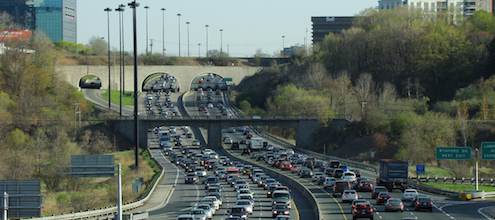
HOV and HOT Lanes: What’s the Difference?
High occupancy vehicle (HOV) and high occupancy toll (HOT) lanes are in the news. A temporary network of HOV lanes was in place in the Toronto area during the recent Pan Am and Parapan Am Games (people were divided about this). And Ontario recently announced that it is moving forward with plans to implement HOT lanes. Both HOV and HOT lanes are tools that influence driving behaviour and road transportation patterns. But, if you are (understandably) confused about the differences between the two, read on.

What are HOV lanes?
No, this is not a reference to hip-hop artist and business tycoon Jay Z’s self-proclaimed pseudonym, HOVA (“…H to the izz-O, V to the izz-A…”).
Common in many parts of the world, HOV lanes can be found on highways in BC, Alberta, Ontario and Quebec. They are designated lanes on roadways open only to vehicles that have multiple passengers (normally a minimum of 2, 3, or 4 passengers). HOV lanes can provide high occupancy vehicles—–carpools and transit buses—with several benefits, including lower travel times, lower fuel costs, and greater travel time reliability, along with wider benefits such as reduced air pollution and greenhouse gas emissions.
Despite their benefits, HOV lanes are often underused, even in peak hours. Why? One reason might be that carpooling doesn’t offer enough of the flexibility that people need in terms of their daily travel routines. Another way to say the same thing is that HOV lanes don’t offer enough of an incentive for people to change their routines to accommodate carpooling. New apps and innovations could help solve that problem in the future by making carpooling easier and more convenient. But people will always need some level of flexibility and choice in how they get around. That brings us to…dah dah da!…HOT lanes.
What’s So Hot about HOT lanes?
HOT lanes are essentially hybrids of HOV lanes and tolled routes; they offer solo drivers the choice to enter HOV lanes for a fee. High occupancy vehicles, including buses, can travel for free as with HOV lanes. Varying the fee for solo drivers to travel in the lane by time-of-day or in response to the number of drivers accessing the lanes makes it possible to ensure that traffic flows smoothly. This provides direct advantages to both the solo drivers that pay the designated price, and multi-passenger vehicles: in particular, faster, more reliable trips. And in cases where HOV lanes are underused, converting them to HOT lanes can increase the overall capacity of a road and improve traffic flows on regular lanes.
The key here is more choice, and also recognition that we all don’t have—and can’t have—cookie-cutter travel routines. Some days we need to get someplace faster than other days. Sometimes we have to leave early or stay late. Sometimes carpooling will work, or taking the train makes sense, but other days we need to drive alone. That’s life. With HOT lanes, people have one more way to opt in to a fast lane when they need it. And that actually helps everyone on the road get where they are going faster.
The United States now has over 470 km of HOT lanes, and more under construction. Canadian cities have yet to introduce them, although Ontario has previously expressed, and recently affirmed, its intent to implement them in the Toronto area.
HOT lanes: One More Tool in the Traffic-Busting Tool Kit
Traffic congestion is costly; by charging road users according to congestion levels, all travellers can benefit from highways with HOT lanes—not just those who use them. Since they incorporate the costs of congestion into the drivers’ decision making, HOT lanes are an ecofiscal approach to managing traffic congestion on our roads, and one of the main forms of congestion pricing.
Our upcoming work on congestion pricing includes more about HOT lanes, including past experience with them, and opportunities for using them in some of Canada’s biggest cities. Stay tuned.




Comments are closed.